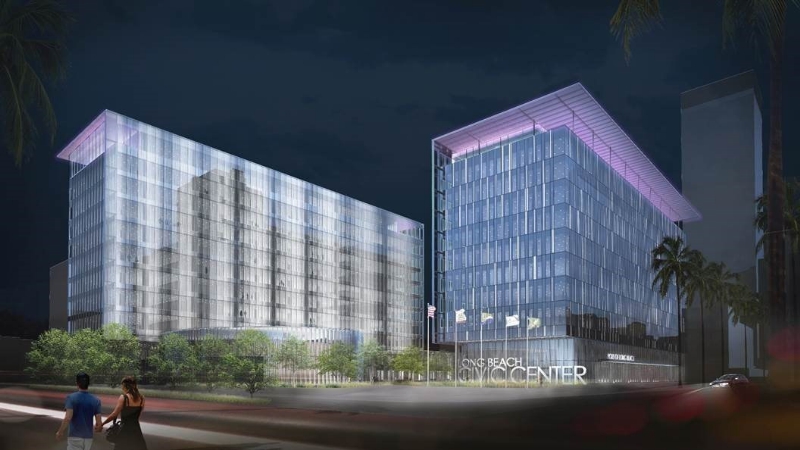Arup announced that the City of Long Beach and Port of Long Beach have reached financial close for the $520 million Long Beach Civic Center Project.
The project includes a new city hall, port HQ, main library, public park, and street improvements. All the features are designed to be occupied within a week of a major earthquake and meet REDi Gold earthquake performance, an operational resilience rating system developed by Arup.
A public-private partnership (P3) was used to fund the project, which combines public infrastructure and private mixed-use real estate development into one design-build-finance-operate-maintain arrangement.
Arup, the global interdisciplinary consulting and design services firm, served as lead advisor to the city and Port of Long Beach. The firm led financial, commercial, real estate, design, engineering, and cost consulting advisory services.
 Long Beach, Calif. Photo: Zen Skillicorn/Creative Commons.
Long Beach, Calif. Photo: Zen Skillicorn/Creative Commons.
The Arup team included HOK for architecture consulting, BAE for real estate economics, and MBI Media for outreach. Sheppard Mullin provided legal advice to the owners.
Plenary Group is the lead P3 developer, sole equity provider, and financial arranger for the consortium, which includes Clark Construction, Edgemoor, Johnson Controls, and SOM.
Allianz, in a private placement, is providing $237 million in long-term financing. Sumitomo Mitsui Banking Corp. is providing a $213 million loan. Long Beach would contribute $11.8 million in cash and land valued at nearly $30 million. Plenary is contributing $21 million in equity.
Arup managed the entire process from the RFP to the end of negotiations and helped the project become a reality quicker than expected.
"A significant value added for the city is how the P3 model accelerated what would more conventionally have been a three- to five-year project development process using traditional project delivery methods to a two-year process," Orion Fulton, Arup's project team leader, said.
Arup has served as an advisor for numerous projects, including Presidio Parkway in San Francisco, the Los Angeles Convention Center, and the New Champlain Bridge in Quebec.
Construction has begun, and the next phase of the project is being launched.
Related Stories
| Nov 13, 2013
Installed capacity of geothermal heat pumps to grow by 150% by 2020, says study
The worldwide installed capacity of GHP systems will reach 127.4 gigawatts-thermal over the next seven years, growth of nearly 150%, according to a recent report from Navigant Research.
| Nov 8, 2013
Oversized healthcare: How did we get here and how do we right-size?
Healthcare facilities, especially our nation's hospitals, have steadily become larger over the past couple of decades. The growth has occurred despite stabilization, and in some markets, a decline in inpatient utilization.
| Nov 8, 2013
S+T buildings embrace 'no excuses' approach to green labs
Some science-design experts once believed high levels of sustainability would be possible only for low-intensity labs in temperate zones. But recent projects prove otherwise.
| Nov 6, 2013
PECI tests New Buildings Institute’s plug load energy use metrics at HQ
Earlier this year, PECI used the NBI metrics to assess plug load energy use at PECI headquarters in downtown Portland, Ore. The study, which informed an energy-saving campaign, resulted in an 18 percent kWh reduction of PECI’s plug load.
| Oct 30, 2013
15 stellar historic preservation, adaptive reuse, and renovation projects
The winners of the 2013 Reconstruction Awards showcase the best work of distinguished Building Teams, encompassing historic preservation, adaptive reuse, and renovations and additions.
| Oct 30, 2013
Why are companies forcing people back to the office?
For a while now companies have been advised that flexibility is a key component to a successful workplace strategy, with remote working being a big consideration. But some argue that we’ve moved the needle too far toward a “work anywhere” culture.
| Oct 30, 2013
11 hot BIM/VDC topics for 2013
If you like to geek out on building information modeling and virtual design and construction, you should enjoy this overview of the top BIM/VDC topics.
| Oct 28, 2013
Urban growth doesn’t have to destroy nature—it can work with it
Our collective desire to live in cities has never been stronger. According to the World Health Organization, 60% of the world’s population will live in a city by 2030. As urban populations swell, what people demand from their cities is evolving.
| Oct 18, 2013
Researchers discover tension-fusing properties of metal
When a group of MIT researchers recently discovered that stress can cause metal alloy to fuse rather than break apart, they assumed it must be a mistake. It wasn't. The surprising finding could lead to self-healing materials that repair early damage before it has a chance to spread.
| Oct 18, 2013
Sustainability expert: Smart building technology can have quick payback
Smart building technology investments typically pay for themselves within one or two years by delivering energy savings and maintenance efficiencies.

















